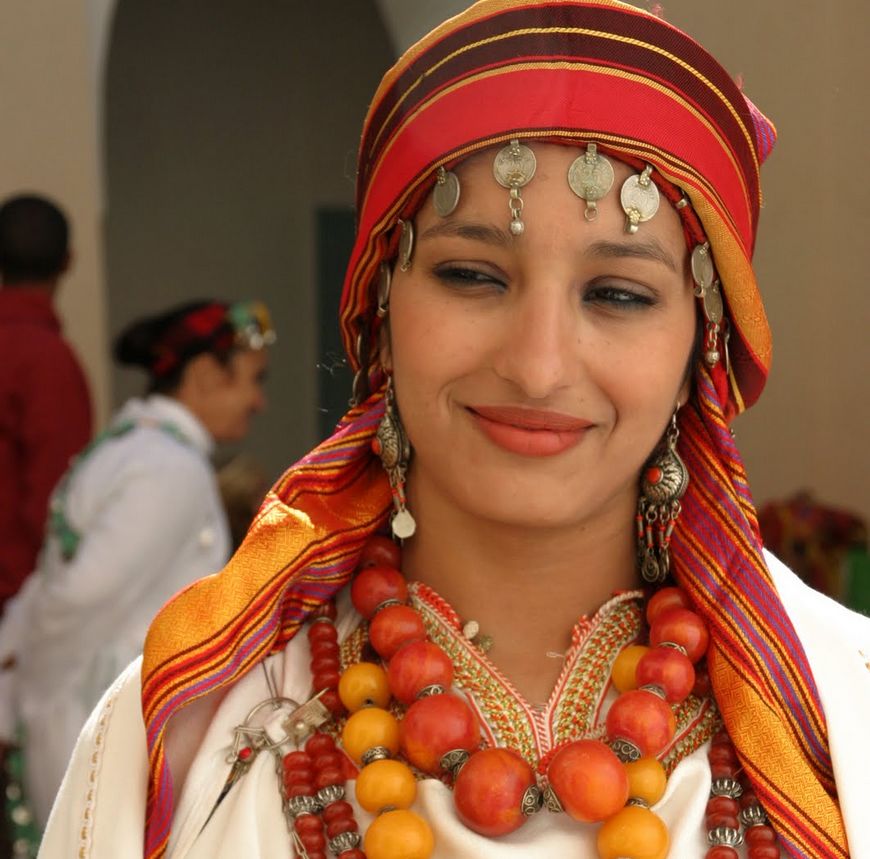The text presented here is "tangguift" by Aît Tghejijt.
Tangguift is wedding rituals.
Marriage among the Chleuhs, as in the whole Maghreb, is a crossroads of social, legal, emotional and moral values.
It's a day that everyone looks forward to at least once in their lives.
Marriage becomes a real legal institution, especially if the woman is subjected to exchange operations.
Marriage is an obligation for every man and the inevitable destiny of every woman, since the strength of the tribal community rests on the family.
Before beginning to comment on this text, it should be recalled that Berber custom reserves a large place for women in Amazigh society.
The woman in Tamazight is called: "tamghart" that is to say the chiefess.
The word tamghart comes from the word amghar which is the delegate or chief of the tribe.
In the event of divorce, Berber custom gives the wife the right to share the house with her husband.
Especially if she helped build the house. This is found in customary law in the Souss region under the name of tamazzalt, which consists in the distribution between the spouses of the goods acquired during the marriage period.
What is undeniable, however, is that the Chleuh marriage is an egalitarian production society, where each person, including the woman, contributes his or her capital and work. The woman's capital is the jihaz*, and her share of the assets the tizzla*. There is nothing similar in Arab countries.
It is true that the Tamazzalt law is not found in any Arab country. Even in Shariaa.
And the new Moroccan moudawwan has just applied this law in the new family code in Morocco.
Lyautey did not miss the opportunity to talk about his admiration for the Amazigh custom, and democracy among the Imazighen.
What characterizes a Berber civilization is the democratic and municipal spirit, a whole set of customs, and last but not least, the use of the Berber language
It has been well said that marriage in the chleuhs, is a crossroads of social values, the first of its values is the honor.
The Amazigh woman, like all Mediterranean women, is intimately linked to the subjective notion of honor.
Several passages in the text clearly show us the importance of honor among the Amazigh, especially on the wedding night.
In the text is the question that the father of the bride to ask his daughter on her wedding night by saying :
tisuranw aylli magh llant? (Where are my keys my daughter?)
He means did you protect our honor?
It should also be noted that the text is not forgotten more religion, moreover tangguift begins with the name of God, the protection of God and that of the Prophet Muhammad.
But what should be noted above all is the influence of Shi'ism in the Amazigh society, in the text we spoke of Ali "the Shi'ite imam" who was the third caliph among the four rightly guided caliphs "al-khulafa' arrachidin", and the father of Hassan and Lahoucine.
This is about Fatima who is Ali's wife.
In the text there are many passages that speak of the cult of saints or maraboutism "attaqarrubu ila l-awliyya wa l-aDriha".
They quote
"sidi Hemad umusa gid adar zewuragh."
"aSSalHin ula lawliyya tas3d n illi"
"aSSalHin ula lawliyya ka sa n-zigiz"
"alacheyakh n darnegh rewaHt ukan ad nmun."
Notes:
* Taghjijt is an oasis 200km south of Agadir. Between Bouizakaren and Tata.
* tilwaH: plural of talluHt it is a wooden board on which the student of the Koranic school calligraphed the Koranic verses to take it by heart.
* Sidi Hmad umusa: a famous saint from the south of Morocco Tazreoult near Tafraout.
* Lalla fatima: Fatima Zahra the daughter of Prophet Mohammed who is the wife of Ali B. Abi Talib.
* Ali: the third "Kalifs Rachidites" the rightly guided caliphs. The spiritual imam of the Shiites.
* Lahcen and Lahoucine: Lahcen is the deviation of Hassan. So they are two sons of Ali b. abi Talib.
1-BEN CHIKH Amina, "La femme amazigh entre le droit coutumier et la modawana", Journal le Monde Amazigh, N 55, Rabat, 15 December 2004.
* jihaz: bringing the bride's possessions into the community.
* tizla: tamazzalt, the devoted one.
2- BERQUE Jacques, Structures sociales du Haut-atlas, Presses universitaires de France, Paris, 1955, P 344.
3- LAFUENTE Gilles, La politique berbère de la France et le nationalisme marocain, L'harmattan, Paris, 1999. P 19.
4- BEN CHIKH Amina, " la femme amazigh entre le droit coutumier et la modawana ", Journal le Monde Amazigh, N 55, Rabat, 15 December 2004.


One Reply to “Mariage Chleuh – Berbère”
Felipe Nissim
Articulo buenisimo..! pero, donde podria encontrar mas informacion sobre las tradiciones nupciales de Kelaat Mguna del area de Rashidia?